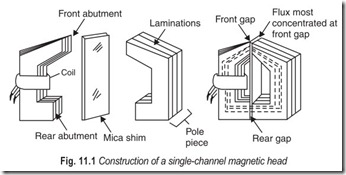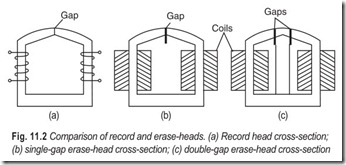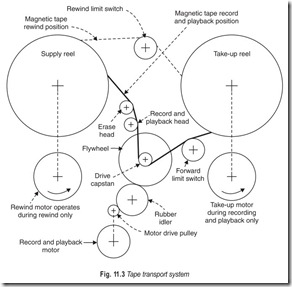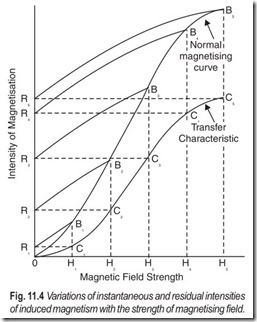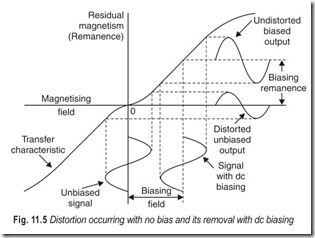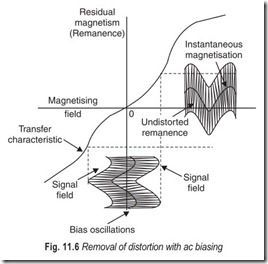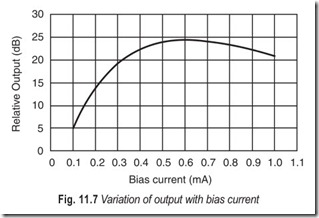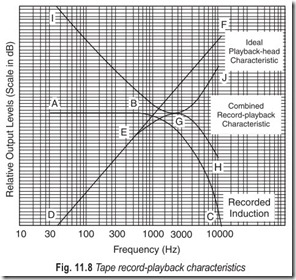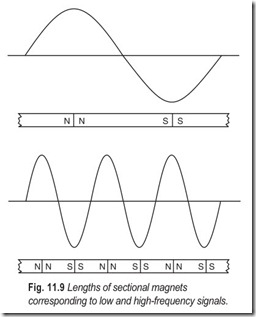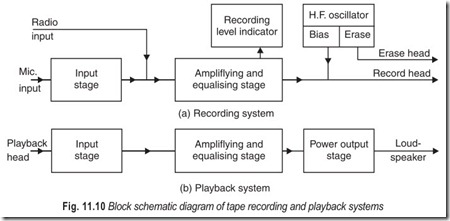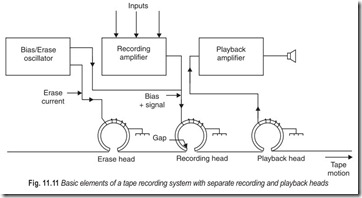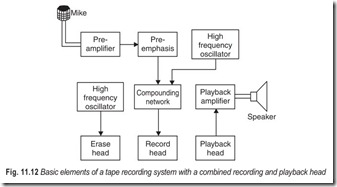DISTORTION IN TAPE EQUIPMENT
A stereo cassette recorder does not justify its place in a hi-fi system on grounds of convenience. As with any other part of the hi-fi system, it must conform to hi-fi standards of frequency range, distortion levels, and signal-to-noise (S/N) ratio. It is because of the deficiencies of cassette recorders in these standards that acceptance of cassette recording in hi-fi has been slow to come.
However, the rate of improvement in quality has now made these standards attainable. High quality cassette recorders are now generally accepted as a part of a complete hi-fi system, used to record material and compile programmes not available on disc, and to replay such material with a quality of reproduction which compares well with other units of the system.
RECORDING AND PLAYBACK HEADS
In a stereo cassette recorder, tape decks (with the exception of some of those used with the so called professional equipment) combine the duties of recording and reproduction in a common head. The requirements of the recording and the playback heads are fundamentally the same and, as they are not required simultaneously economy is served by combining them.
Modern heads are usually constructed of two semicircular stacks of high-permeability laminations of about half to one inch in diameter. The stacks are assembled symmetrically with a head gap (against which the tape passes) of about five to ten thousandth of an inch or less, and an auxiliary gap, diametrically opposite the head gap, of about ten times that width. Both gaps are filled with nonmagnetic metallic shims to prevent any accumulation in the gaps of magnetic material which may be rubbed off the tape by friction, and to maintain a linear relationship between the flux at the gaps and the current through the exciting coils of the head.
The impedance of these coils, which are placed symmetrically about each core should, for recording, be low compared with the source impedance. This ensures, current is independent of the frequency of the signal. For the playback process, however, maximum output voltages are to be gained from high impedance windings. Any conflict between these requirements can be resolved by feeding the output from low impedance coils into a step-up transformer.
Stereophonic heads consist fundamentally of two monaural heads mounted one on top of the other. Each head forms part of a complete playback system, the input signal for which is derived from one of the tracks of specially recorded stereophonic tapes. Facilities for domestic stereophonic recording are seldom provided because of the difficulties to be encountered and the advanced technique required for such an operation.
ERASE HEADS
There are similarities between the erase head and the record head although they differ in their construction in two principal aspects. Firstly, appreciable power is required (about 2 to 4 W) for efficient erasure, for that it is necessary for the recording head to be about 1 mW. Hence the core of the erase head must be of a material having a higher point of magnetic saturation than the material in the recording head. Secondly, the longer the tape is under the influence of the erasing field, the more complete will be the cleaning. Thus the gap in the erase-head core should be considerably larger than in the core of the combined head. The erase gap is usually about fifteen thousandths of an inch wide. Normally there is no auxiliary gap in the core of the erase head. Erase heads with a single gap and a double gap are also available. This is shown in Fig. 11.2.
TAPES
Modern magnetic tapes consist of a non-magnetic base (paper, cellulose acetate or p.v.c. for example) coated with a magnetic material. The base obviously needs to have strength and suppleness. The magnetic material (often red or black iron oxides) is a very finely divided powder mixed in some binding substance (lacquer, for instance), and the coating applied to the base material has to be very smooth.
Unevenness in the surface of the tape will tend to cause broken contact with the heads and consequently an undulating level of recording. The magnetic material needs a high coercivity to prevent, in particular, very large demagnetisation losses at treble frequencies, and a high remanence to give a good level of recording.
Tapes are usually supplied in 5 or 7 inch reels, giving playing times depending on the transport speed and the thickness of the tape, of between 10 and 90 minutes. The standard width of the tape is a quarter of an inch which normally allows for two (and sometimes four) adjacent recording paths. With stereophonic tapes adjacent paths are used for the twin signals comprising the program. The total playing time of such tapes is therefore reduced by half.
TAPE TRANSPORT SYSTEMS
The basic requirement of a tape transport system is that a steady speed should be imparted to the tape. Momentary changes in this speed will cause wow or flutter. Wow results from slow variations; flutter results from fast variations; the dividing line is arbitrary.
The actual speed of transport has a considerable bearing on the performance of the recording apparatus. The higher the speed, the better the performance at the higher frequencies. This is closely allied to the size of the gap in the recording head. But, of course, economically, higher speeds are a disadvantage; the playing time of the tape is obviously reduced. Most transport systems are standardised for playing speeds of either 17/8 , 3 3/ 4 , 7 1/2 or 15 inches of tape per second, with possibly, a choice of speeds. Fig. 11.3 shows how a tape transport system operates.
AMPLITUDE DISTORTION
The non-linear relationship between the magnetism residing on the tape and the magnetic field inducing it, will cause considerable amplitude distortion in the recording.
The curve OB3B5 in Fig. 11.4 shows a typical relationship between the magnetisation produced in a magnetic material and the increasing magnetic field produced in it. A field strength of H2 units, for example, would produce a degree of magnetisation corresponding to the point B2, provided the material was unmagnetised initially, and also provided the field strength was not, at any time during its general increase from zero to H2, caused to diminish. The levels of magnetisation corresponding to B1, B2, etc. are those obtaining when the field strengths are actually H1, H2, and so on. These do not represent residual magnetism.
If the fields are reduced from H1 , H2 and so on to zero, the induced magnetism decreases along the paths B1 R1 , B2 R2 , etc. respectively, and the points R1 , R2 , etc. denote the degrees of residual magnetism, or remanence, induced in the magnetic material by maximum applied field strengths of H1 , H2 , and so on.
The curve OC3 C5 plotted in Fig. 11.4 gives a typical transfer characteristic for a magnetic material; that is, it shows the intensity of residual magnetism (R , R , etc.)
resulting from any given maximum magnetising field (H ,H , etc.). Complete transfer characteristics for positive and negative magnetising fields are shown in Figs. 11.5 and 11.6.
It is obvious from these characteristic curves that the degree of residual magnetism is not a linear function of the maximum magnetising field. Because of this non- linearity, any signal applied to the microphone would, on recording, suffer distortion. All signals would suffer bottom-bend distortion resulting in even harmonics of the fundamental appearing in the recording. Large signals would be further distorted by the magnetic saturation depicted by the flattening of upper sections of the characteristics, and the clipped reproduction would contain a high percentage of odd harmonics of the original.
The middle sections of the arms of the transfer characteristics are, however, approximately linear and if the variations in the magnetic field strengths are confined to these portions, then the recording will be a relatively undistorted replica of the original sound. If a constant current is fed into the recording head together with the signal current, the effect is to lift the variations in the magnetising field above the lower curvature of the characteristic (Fig. 11.5) The dc bias induces a constant degree of magnetisation in the tape on which audio variations are superimposed. Only the variations of the residual magnetism will appear on replaying the recording, so that the bias will not be translated into sound (in fact, some noise does result from the biasing remanence). But because of the limitation imposed by the saturation curvature of the characteristic, the fact that the bias magnetism is added to the audio magnetism, means that the amplitude of the signal must be restricted quite considerably. The signal-to-noise ratio is thus lowered when dc bias is used.
This method of preventing amplitude distortion by introducing a constant biasing current into the recording head together with the signal current has been superseded by a method in which the direct current is replaced by a high-frequency, alternating current. The result is a recording relatively free from harmonic distortion in which a good signal-to-noise ratio is maintained. No complete explanation of the mechanism of ac biasing has yet been accepted generally, but some idea of the process can be obtained from Fig. 11.6.
A feature of this method of biasing is the fact that no residual magnetism is induced in the tape by the ac signal provided, of course, that these oscillations are free from even harmonic distortion. As any point on the tape passes the gap in the recording head, it is subjected to a rapidly alternating magnetic field, the strength of which increases as the point approaches the gap and dies away as the point recedes. Such a process causes no remanence in the tape. Only the audio-variations, which are superimposed on the ac field cause any residual magnetism, and because of the bias, this magnetism depends linearly on the audio signal. Thus, the tape is not loaded with any wasted remanence as it is when dc biasing is used. In addition to this, it will be seen from Fig. 11.6 that both linear sections of the transfer characteristic can be used. It follows then that the limitations imposed by dc biasing on the strength of the audio signal can be relaxed considerably without increasing the danger of approaching the saturation level of the tape. An ac bias, therefore, reduces bottom bend distortion and, compared with dc biasing gives an improved signal-to-noise ratio.
Initially an increase in the ac biasing current for a given signal strength lessens the distortion of the recorded signal and increases the level of recording. But too much bias will cause top bend distortion and will also cause a lessening in the output, especially for treble signals. The bias acts very much in the manner of the erase signal. A typical variation of the output with bias current is shown in Fig. 11.7.
ERASING
The field associated with ac biasing signal does not cause any residual magnetism in a tape passing through the field. If the tape is unmagnetised when the signal is applied, then it will be unmagnetised when it is passing through the field.
If the amplitude of the ac signal is sufficient to saturate the tape, then even if the tape is not unmagnetised originally, it will be so when it has travelled through the field. This fact is used in the erase heads of most magnetic recording equipment. The tape is drawn through a strong local magnetic field arising from a high- frequency alternating current in the erase head. As each point of the tape travels into the field, it is saturated, and as each point recedes, it is subjected to a field strength which diminishes to zero some distance from the head. By this process it is cleaned of all previous magnetisation.
OSCILLATOR COIL
The bias oscillator should generate a sine-wave with negligible harmonic distortion to keep noise to a minimum. Symmetry in the waveform is essential. An unsymmetrical sine-wave has, in fact, a dc component made up of the difference between the positive and negative amplitudes of the sine-wave. This will introduce noise in the recording and impart some wasted remanence to the tape.
It is usual for the oscillator transistor to provide both bias and erase currents. In most of the commercial tape decks, the combined record-playback head is usually of high impedance, while the impedance of the erase head may be high or low. To accommodate low-impedance erase heads, a separate oscillator output, in the form of a secondary winding to the oscillator coil, is required for matching purposes. Some degree of flexibility is possible if a tapped secondary winding is used, to suit all types of erase heads.
FREQUENCY RESPONSE
The degree of magnetisation of the tape which results from recording with a current through the head, which is constant at all frequencies, is of the form shown by the curve ABC of Fig. 11.8. The reduced intensity in the treble region is attributable to self-demagnetisation of the tape.
To outline the recording process briefly, the tape is drawn steadily past the recording head, and the field produced by the signal current in the head induces some degree of residual magnetism in the section of the tape nearest to the head. The amplitude of the signal governs the amount of magnetism, and the sense (whether positive or negative) controls the direction of the magnetism in each section.
On the basis of molecular theory of magnetism, the molecular magnets in the tape are aligned by the magnetising field. The strength of the field governs how many of these magnets are brought into line. The direction of the field dictates whether the alignment is with north or south pole.
The field set-up by a sinusoidal signal current in the head would change direction regularly, so that the pattern of magnetism induced in the tape would have adjacent sections of the tape with north and south poles leading alternately (see Fig. 11.9). Thus, the poles of each section of the tape would be adjacent to the like poles of the neighbouring sections.
The length of these sectional magnets in the tape depends on the speed at which the tape passes the head, and on the frequency at which the magnetising field changes direction. For a constant transport speed the length varies inversely as the frequency of the signal. For low-frequency signals the magnets are comparatively long, but for high-frequency signals they are short.
For the playback process, the magnetised tape is drawn past the playback head at a constant speed, and the magnetic fields associated with the sections of the tape move and cut the coils of the head, thereby setting up voltages in the coils. The rate of change of flux cutting the coils governs the voltage generated. Thus, the rapidly changing fields set up by the sections of the tape on which high-frequency sounds have been recorded must of necessity give rise to larger voltages than the sections containing low-frequency impressions. This is so, even if the impressions at both high and low-frequencies have the same intensity of magnetisation. The actual speed of the tape has no bearing on the relative levels of the output at the various frequencies. An increase in the transport speed simply multiplies all levels by the same amount.
The rate at which the playback voltage rises with frequency is equivalent to 6 dB per octave. In Fig. 11.8, the line DEF indicates the frequency response of the playback head only (a tape which has been ideally magnetised is assumed for this response curve). The response for the recording head alone will depend on various practical considerations. For example, a tape made of a magnetic material of high coercivity is difficult to demagnetise. The use of a high-correcivity tape, of course, makes intentional erasing more difficult.
EQUALISATION
The response for complete equipment, (that is, the response combining both recording and playback deviations) is indicated by the DEGH of Fig. 11.8. To obtain an equalised output from this response curve it is necessary to introduce boost at both ends of the frequency range. For ideal equalisation the compensating curve must be a mirror image of the curve DEGH, so that the equalising response curve needs to be the curve IGJ.
There will be, in fact, further high-frequency losses encountered in tape recording. The tendency of the ac bias signal to act as an erasing signal during the recording process is more pronounced at high frequencies because the remanence is less deeply seated at these frequencies. Also, the physical dimensions of the gap in the playback head cause losses when the size of the sectional magnets and the gap are commensurate (this is usually referred to as gap effect). These combine to produce a more accentuated drop in the response curve in the treble region.
Unfortunately, equalisation is not simply a matter of compensating for bass and treble deviations. Several performance requirements are in conflict, and a compromise is the best that can be achieved. A wide frequency response, low distortion or a high signal-to-noise ratio can each be obtained at the expense of the others. Over a restricted range, an increase in bias current, for example, lessens distortion, but causes treble attenuation and tends to lessen the signal-to-noise ratio. Furthermore equalisation is a function of the physical properties of the tape used. The equalisation provided with any combination of tape deck and amplifier may, for example provide a level response over a wide frequency range with one brand of tape, but may give rise to a large treble peak with another brand.
BLOCK DIAGRAM
A tape amplifier can be represented essentially by the block schematic diagram of Fig. 11.10. Normally, the design of both (recording and playback) units will follow general a.f. practice, although attention must be paid to certain requirements of the equipment. Precautions will be required to minimise hum pick-up, and the overall signal-to-noise ratio should be at least 40 dB.
The attenuation of the bass response in a tape recorder takes place mainly in the playback head. The treble response suffers its greatest losses in the recording process. Thus, in order to load the tape more or less evenly, it is best to provide treble boost in the recording amplifier and to apply bass boost in the playback amplifier. Some treble accentuation may also be required in the playback amplifier, but this has to be limited in order to avoid excessive amplification of the background noise.
Basic elements of a tape recording system with separate recording and playback heads is given in Fig. 11.11 and that of a tape recording system with a combined recording and playback head is given in Fig. 11.12. Both the systems are self-explanatory.
EXERCISES
Descriptive Questions
1. Explain the construction of a magnetic head with the help of a suitable diagram.
2. Differentiate between recording, playback and earse heads.
3. What are the factors which influence the recording and playback characteristics of a tape recorder?
4. How are the deviations in the recording and playback characteristics of a tape recorder compensated for?
5. What are the requirements of a tape transport system?
6. Explain the functioning of a tape system with the help of a block diagram.
Multiple Choice Questions
1. Tape decks combine the functions of
(a) recording (b) reproduction
(c) (a) and (b) (d) none of the above
2. Modern heads are usually constructed of two semi-circular stacks of high-permeability laminations assembled
(a) symmetrically (b) asymmetrically
3. Each stereophonic head forms part of a complete
(a) recording system (b) playback system
(c) (a) or (b) (d) (a) and (b)
4. Power required for efficient erasure is approximately
(a) 1 to 2 W (b) 2 to 6 W
(c) 2 to 4 W (d) 4 to 8 W
5. Erase heads are available with a
(a) single gap (b) double gap
(c) (a) and (b) (d) none of the above
6. Unevenness in the surface of the tape will cause
(a) increased level of recording (b) decreased level of recording
(c) undulating level of recording (d) none of the above
7. The higher the speed the better the performance at
(a) all frequencies (b) low frequencies
(c) medium frequencies (d) high frequencies
8. The non-linear relationship between the magnetism residing on the tape and the magnetic field inducing it will cause considerable
(a) phase distortion (b) harmonic distortion
(c) amplitude distortion (d) intermodulation distortion
9. Bottom-bend distortion results in
(a) even harmonics of the fundamental
(b) odd harmonics of the fundamental
10. With dc biasing signal-to-noise ratio is
(a) unaffected
(b) increased
(c) lowered
11. With ac biasing
(a) no residual magnetism is induced in the tape
(b) residual magnetism is induced in the tape
12. Too much bias will cause
(a) top bend distortion (b) bottom bend distortion
13. Too much bias causes lessening of the output, especially for
(a) bass signals (b) treble signals
14. Symmetry of the waveform of the oscillator coil is
(a) essential (b) not essential
15. It is usual for the oscillator transistor to provide
(a) bias current (b) erase current
(c) bias and erase currents
16. For a constant transport speed, the length of the magnet varies
(a) directly as the frequency (b) inversely as the frequency
17. To obtain an equalised output, it is necessary to introduce boost at
(a) lower end of the frequency range (b) top end of the frequency range
(c) both ends of the frequency range (d) none of the above
18. Equalisation is a function of the
(a) physical properties of the tape used (b) chemical properties of the tape used
(c) composition of the tape used (d) dimensions of the tape used
19. The attenuation of bass response in a tape recorder takes place in the
(a) recording head (b) playback head
20. The treble response suffers its greatest losses in the
(a) playback process (b) recording process
Fill in the Blanks
1. Both gaps are filled with non magnetic shim to maintain a………………………………..relationship between the flux at the gaps and the current through the exciting coils of the head.
2. Appreciable power is required for………………………………..erasure.
3. The longer the tape is under the influence of the erasing field the more……………………………….. will be the erasure.
4. The base of the magnetic tape needs to have……………………………….. and suppleness.
5. Tapes are usually supplied in………………………………..or………………………………..inch reels.
6. For stereophonic tapes……………………………….. paths are used for twin signals of the program.
7. The basic requirement of a tape transport system is to impart a……………………………….. to the tape.
8. Too much bias will cause………………………………..distortion.
9. Some degree of flexibility is possible if a ……………………………….. secondary is used to suit all types of erase heads.
10. The use of a high-coercivity tape makes ……………………………….. erasing more difficult.
11. Physical dimensions of the gap in the playback head cause losses when the size of the sectional magnets and the gap are …………………………………
12. It is best to apply……………………………….. boost in the recording amplifier and to apply boost in the playback amplifier.
ANSWERS
Multiple Choice Questions
|
1. (c) |
2. (a) |
3. (b) |
4. (c) |
5. (c) |
6. (c) |
|
7. (d) |
8. (c) |
9. (a) |
10. (c) |
11. (a) |
12. (a) |
|
13. (b) 19. (b) |
14. (a) 20. (b) |
15. (c) |
16. (b) |
17. (c) |
18. (a) |
Fill in the Blanks
|
1. linear |
2. efficient |
3. complete |
|
4. strength 7. constant speed 10. intentional |
5. five, seven 8. top bend 11. comparable |
6. separate 9. tapped 12. treble, bass |
